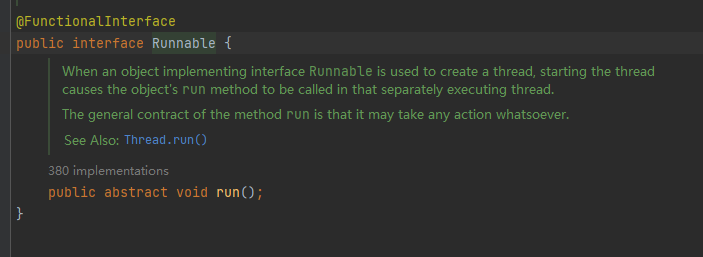函数式编程思想与应用
# 思想
面向对象思想需要关注用什么对象完成什么事情,而函数式编程思想主要关注于对数据进行了什么样的操作。
# 优点
- 代码简洁
- 接近自然语言
- 易于并发编程
# Lambda表达式
# 概述
对某些匿名内部类的写法进行简化,是函数式编程思想的一个重要体现。
# 核心原则
可推导 可省略
# 基本格式
(参数列表)->{代码}
# 简单举例
new Thread(new Runnable() {
@Override
public void run() {
System.out.println("线程匿名内部类执行");
}
}).start();
new Thread(()->{
System.out.println("线程Lambda执行");
}).start();

# 使用条件
- 调用的方法入参使用了函数式接口
- 业务处理需要使用函数式接口的方法
# 关注点
我们不需要关注接口具体叫什么名字,也不需要关注接口下的方法叫什么名字。我们只需要关注方法所需的参数列表和具体代码逻辑即可。
# 复杂例子
public static void main(String[] args) {
ArrayList<String> strings = new ArrayList<>();
strings.add("a");
strings.add("b");
strings.add("c");
strings.add("d");
forEach(strings,t-> System.out.println(t.toUpperCase()));
System.out.println(strings);
}
public static void forEach(List<String> list, Consumer<String> consumer) {
for (String s1 : list) {
consumer.accept(s1);
}
}
public class LambdaTest {
public static void main(String[] args) {
//匿名内部类重写
Integer integer = convertType(new Function<String, Integer>() {
@Override
public Integer apply(String s) {
return Integer.valueOf(s);
}
});
System.out.println(integer);
//Lambda表达式重写
Integer integer1 = convertType(s -> Integer.valueOf(s));
System.out.println(integer1);
}
public static <R> R convertType(Function<String,R> function){
String str = "12345";
R r = function.apply(str);
return r;
}
}
# 简写规则
- 参数类型可以省略
- 方法体只有一句代码时大括号return和唯一一句代码的分号可以省略
- 方法只有一个参数时小括号可以省略
# Stream流
# 概述
Stream使用的是函数式编程模式,它可以被用来对集合和数字进行链状流式的操作。可以更加方便的让我们对集合和数组进行操作。
# 过程
使用Stream流处理数据,主要分为创建流、中间操作和终结操作三个步骤
# 创建流
- 单列集合
集合对象.stream()
List<Author> authors = getAuthors();
Stream<Author> stream = authors.stream();
- 数组
Arrays.stream(数组)或者使用Stream.of进行创建
String[] strings = {"1","a","b","f"};
Stream<String> stream1 = Arrays.stream(strings);
Stream<String> strings1 = Stream.of(strings);
- 双列集合 :转换成单列集合再创建
HashMap<String, String> hashMap = new HashMap<>();
hashMap.put("江苏","南京");
hashMap.put("浙江","杭州");
hashMap.put("安徽","合肥");
Stream<Map.Entry<String, String>> stream1 = hashMap.entrySet().stream();
# 中间操作
# 数据准备
package com.example.springbootdemo.stream.entity;
import lombok.AllArgsConstructor;
import lombok.Data;
import lombok.EqualsAndHashCode;
import lombok.NoArgsConstructor;
@Data
@AllArgsConstructor
@NoArgsConstructor
@EqualsAndHashCode
public class Book {
//id
private Long id;
//书名
private String name;
//分类
private String category;
//评分
private Integer score;
//简介
private String intro;
}
package com.example.springbootdemo.stream.entity;
import lombok.AllArgsConstructor;
import lombok.Data;
import lombok.EqualsAndHashCode;
import lombok.NoArgsConstructor;
import java.util.List;
@Data
@NoArgsConstructor
@AllArgsConstructor
@EqualsAndHashCode
public class Author {
//id
private Long id;
//姓名
private String name;
//年龄
private Integer age;
//简介
private String intro;
//作品
private List<Book> books;
}
package com.example.springbootdemo.stream;
import com.example.springbootdemo.stream.entity.Author;
import com.example.springbootdemo.stream.entity.Book;
import java.util.*;
public class TestMain {
public static void main(String[] args) {
//Write Your Code
}
public static List<Author> getAuthors(){
Book book = new Book(1L,"雪山飞狐","武侠",90,"雪山飞狐讲述了");
Book book1 = new Book(2L,"连城诀","武侠",92,"连城诀讲述了");
Book book2 = new Book(3L,"笑傲江湖","武侠",96,"笑傲江湖讲述了");
Book book3 = new Book(4L,"哈里波特","魔法,武侠",96,"哈利波特讲述了");
Book book4 = new Book(5L,"三体","科幻",97,"三体讲述了");
ArrayList<Book> jyBooks = new ArrayList<>();
jyBooks.add(book);
jyBooks.add(book1);
jyBooks.add(book2);
Author author = new Author(1L, "金庸", 53, "武侠小说家", jyBooks);
ArrayList<Book> jkBooks = new ArrayList<>();
jkBooks.add(book3);
Author author1 = new Author(2L, "JK.罗琳", 45, "魔法小说家", jkBooks);
ArrayList<Book> cxBooks = new ArrayList<>();
cxBooks.add(book4);
Author author2 = new Author(3L, "刘慈欣", 30, "科幻小说家", cxBooks);
List authors = new ArrayList<Author>();
authors.add(author);
authors.add(author1);
authors.add(author2);
return authors;
}
}
# filter
可以对流中的元素进行条件过滤,符合过滤条件的才能继续留在流中。
//打印出所有年龄大于40的作者名称
List<Author> authors = getAuthors();
authors.stream()
.filter(author -> author.getAge() >40)
.forEach(author -> System.out.println(author.getName()));
# map
可以把对流中的元素进行计算或转换
//转换 : 打印所有作家的名字
List<Author> authors = getAuthors();
authors.stream()
.map(author -> author.getName())
.forEach(name -> System.out.println(name));
//计算 : 将所有作家的年龄加10再打印输出年龄
List<Author> authors = getAuthors();
authors.stream()
.map(author -> author.getAge()+10)
.forEach(age -> System.out.println(age));
# distinct
可以去除流中的重复元素。
注意:distinct()方法是依赖Object的equals方法来判断是否是相同对象的,所以要注意重写equals方法
//去重 : 打印所有作家的名字
List<Author> authors = getAuthors();
authors.stream()
.distinct()
.forEach(name -> System.out.println(name))
# sorted
可以对流中的元素进行排序

//对流中的元素按照年龄进行降序排序
无参方法(需要流中的元素类实现Compared接口):
package com.example.springbootdemo.stream.entity;
import lombok.AllArgsConstructor;
import lombok.Data;
import lombok.EqualsAndHashCode;
import lombok.NoArgsConstructor;
import java.util.List;
@Data
@NoArgsConstructor
@AllArgsConstructor
@EqualsAndHashCode
public class Author implements Comparable<Author>{
//id
private Long id;
//姓名
private String name;
//年龄
private Integer age;
//简介
private String intro;
//作品
private List<Book> books;
@Override
public int compareTo(Author o) {
return o.getAge() - this.getAge();
}
}
//调用方法
List<Author> authors = getAuthors();
authors.stream()
.sorted()
.forEach(author -> System.out.println(author));
有参方法,直接使用Lambda表达式,无需重写Compared接口
List<Author> authors = getAuthors();
authors.stream()
.sorted(((o1, o2) -> o2.getAge() - o1.getAge()))
.forEach(author -> System.out.println(author));
# limit
可以设置流的最大长度,超出部分将会被抛弃
//找出年龄最大的两个作家
List<Author> authors = getAuthors();
authors.stream()
.sorted(((o1, o2) -> o2.getAge() - o1.getAge()))
.limit(2)
.forEach(author -> System.out.println(author));
# skip
跳过流中的前n个元素,返回剩下的元素
//找出除年龄最大的所有作家
List<Author> authors = getAuthors();
authors.stream()
.sorted(((o1, o2) -> o2.getAge() - o1.getAge()))
.skip(1)
.forEach(author -> System.out.println(author));
# flatMap
map只能把一个对象转换成另一个对象作为流中的元素。而flatMap可以把一个对象转换成多个对象作为流的对象。
通过以下代码,如果我们使用Map处理实际上得到的是三个作者名下的List集合的书籍
//打印所有书籍名字
List<Author> authors = getAuthors();
authors.stream()
.map(author -> author.getBooks())
.forEach(books -> System.out.println(books));
[Book(id=1, name=雪山飞狐, category=武侠, score=90, intro=雪山飞狐讲述了), Book(id=2, name=连城诀, category=武侠, score=92, intro=连城诀讲述了), Book(id=3, name=笑傲江湖, category=武侠, score=96, intro=笑傲江湖讲述了)]
[Book(id=4, name=哈里波特, category=魔法, score=96, intro=哈利波特讲述了)]
[Book(id=5, name=三体, category=科幻, score=97, intro=三体讲述了)]
我们可以使用flapMap方法,将bookList拿出来转换成Stream,这时候会自动拼接成Book的流
//打印所有书籍名字
List<Author> authors = getAuthors();
authors.stream()
.flatMap(author -> author.getBooks().stream())
.forEach(books -> System.out.println(books));
Book(id=1, name=雪山飞狐, category=武侠, score=90, intro=雪山飞狐讲述了)
Book(id=2, name=连城诀, category=武侠, score=92, intro=连城诀讲述了)
Book(id=3, name=笑傲江湖, category=武侠, score=96, intro=笑傲江湖讲述了)
Book(id=4, name=哈里波特, category=魔法, score=96, intro=哈利波特讲述了)
Book(id=5, name=三体, category=科幻, score=97, intro=三体讲述了)
//打印输出所有书籍的类型,但是不能出现(,)
List<Author> authors = getAuthors();
authors.stream()
.flatMap(author -> author.getBooks().stream())
.flatMap(book -> Stream.of(book.getCategory().split(",")))
.distinct()
.forEach(category -> System.out.println(category));
# 终结操作
# forEach
对流中的元素进行遍历操作,我们通过传入的参数去指定遍历的元素进行具体什么操作
//打印出所有的作者信息
List<Author> authors = getAuthors();
authors.stream()
.forEach(author -> System.out.println(author));
# count
用来获取当前流中元素的个数
//打印输出所有书籍类型的个数
long count = authors.stream()
.flatMap(author -> author.getBooks().stream())
.flatMap(book -> Stream.of(book.getCategory().split(",")))
.distinct()
.count();
System.out.println(count);
# max&min
用来取流中的最值
//输出得分最高和最低书籍的信息
List<Author> authors = getAuthors();
Optional<Book> max = authors.stream()
.flatMap(author -> author.getBooks().stream())
.max((a, b) -> a.getScore() - b.getScore());
System.out.println(max.get());
Optional<Book> min = authors.stream()
.flatMap(author -> author.getBooks().stream())
.min((a, b) -> a.getScore() - b.getScore());
System.out.println(min.get());
# collect
把当前流转换成一个集合
List<Author> authors = getAuthors();
//获取作者名字的List集合
List<String> collect = authors.stream()
.map(author -> author.getName())
.collect(Collectors.toList());
//获取作者名字的Set集合
Set<String> collect1 = authors.stream()
.map(author -> author.getName())
.collect(Collectors.toSet());
//获取<作者名字,List<Book>>的map
Map<String, List<Book>> collect2 = authors.stream()
.collect(Collectors.toMap(author -> author.getName(), author -> author.getBooks()));
//根据作家类型分类
Map<String, List<Author>> collect3 = authors.stream()
.collect(Collectors.groupingBy(author -> author.getIntro()));
# anyMatch
可以用来判断是否有任意符合匹配条件的元素,结果为Boolean类型
//判断是否有年龄小于等于三十的作家
boolean b = authors.stream()
.anyMatch(author -> author.getAge() <= 30);
System.out.println(b);
# allMatch
可以用来判断是否都符合匹配条件,结果为boolean类型。如果都符合结果为true,否则为false。
//判断是不是所有作家都是成年人
boolean b = authors.stream()
.allMatch(author -> author.getAge()>18);
# noneMatch
可以用来判断是否都不符合条件,结果为boolean类型。如果都不符合结果为true,否则为false。
//判断是不是所有作家都不是成年人
boolean b = authors.stream()
.noneMatch(author -> author.getAge()>18);
# findAny
获取流中的任意一个元素。该方法没有办法保证获取的一定是流中的第一个元素。
//输出任意一个作家的姓名
authors.stream()
.findAny()
.ifPresent(author1 -> System.out.println(author1.getName()));
# findFirst
获取流中的第一个元素。
//输出年龄最小的作家名字
authors.stream()
.sorted((a,b)-> a.getAge()-b.getAge())
.findFirst()
.ifPresent(person -> System.out.println(person.getName()));
# reduce
对流中的数据按照你制定的计算方式计算出一个结果。
reduce的作用是把Stream中的元素给组合起来,我们可以传入一个初始值,它会按照我们的计算方式依次拿流中的元素和在初始值的基础上进行计算,计算结果再和后面的元素计算。
T result = identity;
for(T element : this.stream)
result = accumulator.apply(result,element)
return result;
其中identity就是我们可以通过方法参数传入的初始值,accumulator的apply具体进行什么计算实际上也是由我们自己决定。
//输出所有作家年龄之和 + 2
Integer reduce = authors.stream()
.map(author -> author.getAge())
.reduce(2, (a,b)-> a+b);
System.out.println(reduce);
# 总结
- 流是一次性的(一旦一个流对象进行终结操作,这个流就不能再被使用)
- 不会影响原数据
